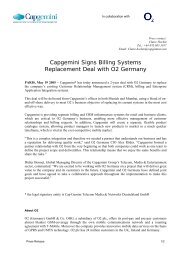INTRODUCTION TO THE CAPGEMINI GROUP
INTRODUCTION TO THE CAPGEMINI GROUP
INTRODUCTION TO THE CAPGEMINI GROUP
Create successful ePaper yourself
Turn your PDF publications into a flip-book with our unique Google optimized e-Paper software.
2<br />
2. <strong>INTRODUCTION</strong> <strong>TO</strong> <strong>THE</strong> <strong>CAPGEMINI</strong> <strong>GROUP</strong><br />
protects its networks via security rules and firewalls. It also has<br />
an established IT security policy. For some projects or clients,<br />
enhanced systems and network protection is provided on a<br />
contractually-agreed basis.<br />
Offshoring<br />
Capgemini’s evolving production model, Rightshore ® , involves<br />
transferring a portion of the Group’s production of part of its<br />
services to sites or countries other than those in which the<br />
services are used or in which the Group’s clients are located<br />
and particularly India, Poland, China, Vietnam and Latin<br />
America. The development of this model has made the Group<br />
more reliant on telecommunications networks, which may<br />
increase the risk of business interruption at a given production<br />
site due to an incident or a natural disaster, in so far as several<br />
operational units could be affected simultaneously. The use of<br />
a greater number of production sites provides the Group with a<br />
wider range of options in the event of a contingency.<br />
Environment<br />
As an intellectual service provider, Capgemini’s activities have a<br />
moderate impact on the environment. Nevertheless, the Group<br />
strives to limit the environmental impact of its activities, as<br />
described in the corporate responsibility and sustainability section<br />
(Section 3.5, The Group and the environment). The risks in this<br />
respect are not deemed material.<br />
Clients<br />
Capgemini serves a large client base, in a wide variety of sectors<br />
and countries. The Group’s biggest clients are multinationals and<br />
public bodies. The Group’s largest client, a major British public<br />
body, contributes 10% of Group revenues, while the secondlargest<br />
client accounts for just 2%. The top 10 clients collectively<br />
account for just over 23% of Group revenues, and the top 30<br />
represent just over 37%. The credit-worthiness of these major<br />
clients and the sheer diversity of the other smaller clients help<br />
limit credit risk.<br />
Suppliers and sub-contractors<br />
Capgemini is dependent upon certain suppliers, especially in<br />
its Technology Services businesses. While alternative solutions<br />
exist for most software and networks, certain projects may<br />
be adversely affected by the failure of a supplier with specific<br />
technologies or skills.<br />
Country risks<br />
Capgemini has permanent operations in approximately<br />
30 countries. The bulk of its revenues is generated in Europe and<br />
North America, which are economically and politically stable.<br />
An increasing portion of its production is based in emerging<br />
countries, and primarily India, which now represents<br />
approximately 28% of the Group’s total headcount. Consequently,<br />
Capgemini is now more exposed to the risk of natural disasters in<br />
South East Asia and Latin America, political instability in certain<br />
regions of India and adjoining countries, and even terrorist attacks.<br />
26<br />
REFERENCE DOCUMENT 2010 <strong>CAPGEMINI</strong><br />
From an economic standpoint, the Group is also exposed to risks<br />
stemming from the negative effects of insufficiently controlled<br />
growth (wage inflation, which is particularly rife in the IT sector,<br />
inadequate domestic infrastructure and higher taxes).<br />
Strict approval criteria must be met before employees are sent to<br />
work in countries where there are no existing Group operations,<br />
and even stricter criteria apply in the event that employees are<br />
sent to countries considered “at risk”.<br />
External growth<br />
External growth transactions, one of the cornerstones of the<br />
Group’s development strategy, also contain an element of risk.<br />
Integrating any newly-acquired company or activity, particularly<br />
in the service sector, may prove to be a longer and more difficult<br />
process than predicted. The success of an external growth<br />
transaction largely depends on the extent to which the Group<br />
is able to retain key managers and employees, maintain the<br />
client base intact, coordinate development strategy effectively,<br />
especially from an operating and commercial perspective, and<br />
dovetail and/or integrate information systems and internal<br />
procedures. Unforeseen problems can generate higher integration<br />
costs and/or lower savings or synergies than initially forecast. If<br />
a material unidentified liability subsequently comes to light, the<br />
value of the assets acquired may turn out to be lower than their<br />
acquisition cost.<br />
Economic conditions<br />
The Group’s growth and financial results may be adversely<br />
affected by a general downturn in the IT service sector or in one of<br />
Capgemini’s other key business segments. A shake-up resulting in<br />
a change of ownership at one of Capgemini’s clients or a decision<br />
not to renew a long-term contract may have a negative effect on<br />
revenue streams and require cost-cutting or headcount reduction<br />
measures in the operational units affected.<br />
LEGAL RISKS<br />
The Group’s activities are not regulated and consequently do<br />
not require any specific legal, administrative or regulatory<br />
authorization.<br />
In the case of some services, such as outsourcing or specific<br />
projects carried out for clients whose activities are regulated,<br />
the Group itself may be required to comply with contractual<br />
obligations related to such regulations.<br />
Draft agreements are submitted to the Legal department for<br />
review when their terms and conditions derogate from the<br />
principles governing the Group’s contractual relations. However,<br />
in spite of the stringent control procedures that the Group<br />
applies regarding the terms and conditions of the agreements to<br />
which it is party, it is impossible to guarantee that all risks have<br />
been contained and eliminated.















